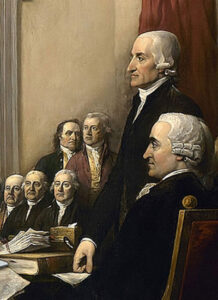 Like their European forbearers, America’s founding fathers wore powdered wigs. It conferred a sense of stature as only the wealthy could afford them. It also suggested a measure of wisdom that society associated with its elder statesmen. White hair was a symbol of respect. My, how far we have come!
Like their European forbearers, America’s founding fathers wore powdered wigs. It conferred a sense of stature as only the wealthy could afford them. It also suggested a measure of wisdom that society associated with its elder statesmen. White hair was a symbol of respect. My, how far we have come!
Today’s fashion, advertising, and entertainment industries focus on young people. A tiny percentage of characters on TV are elderly, and they’re generally relegated to minor and/or unflattering roles. In 2016, just 11% of all speaking characters across the top 100 films were older, and 44% of those films included ageist comments. Among top grossing films, women over 50 rarely appear in leading roles. In testimony to Congress, actress Doris Roberts noted:
“My peers and I are portrayed as dependent, helpless, unproductive, and demanding rather than deserving… In reality, the majority of seniors are self-sufficient middle-class consumers with more assets than most young people and the time and talent to offer society… The latter years can be some of the most productive and creative.”
Dr. Becca Levy tackles ageism in Breaking the Age Code: How Your Beliefs About Aging Determine How Long and Well You Live. She found that 82% of older Americans experience ageism regularly. Employers don’t take their candidacy seriously even though older adults have more experience, lower turnover rates, and higher reliability on the job. Physicians tend to dismiss older patient symptoms and/or dole out medications rather than invest in more rigorous evaluation. Of publicly available Facebook groups having to do with aging, 74% vilified older people, 27% infantilized them, and 37% advocated banning them from public activities.
Based on 400+ studies conducted across 5 continents, Levy tells us that negative age beliefs bring about detrimental health outcomes:
- Physiologically: increased biomarkers for stress1 with the attendant risk of chronic disease; poorer recovery rates from illness and injury; elevated levels of plaques and tangles2 in the brain
- Behaviorally: decreased practice of healthy behaviors based on a belief that they won’t prove useful; social isolation
- Psychologically: increased incidence of low self-esteem, depression
Cultures with positive age beliefs (e.g., Japan, China) offer seniors an entirely different experience. Older people receive attentive care, the respect of younger generations, and full access to the social life of their communities. Rather than seeing themselves as feeble, dependent, daft, or outdated, their self-image finds expression as wise, spry, fit, curious, lively, joyful, and resilient.
Adults who hold positive age beliefs (or are primed with them) engage in a self-reinforcing cycle of healthy physical, cognitive, and emotional behaviors. As a result, they demonstrate increased ability to resist and cope with stress at a biological level. They’re 44% more likely to recover fully from illness or injury. They’re 47% less likely to develop dementia. And, according to the Ohio Longitudinal Study on Aging, they add 7.5 years to their lifespan. Levy says:
“Positive age beliefs have a double benefit for longevity. In addition to the likelihood of a longer life, the various rewards these beliefs provide make it more likely the longer life will be a fulfilling and creative one.”
Catching ourselves and others in negative age stereotypes represents an important first step toward eradicating such beliefs. A few scientific facts support that process:
- The brain sprouts new neural connections throughout our lifetimes provided it receives the proper stimulus. Word to the wise: Be a lifelong learner. Socialize!
- Semantic memory (i.e., general knowledge) improves with age; procedural memory stays the same. Episodic memory (i.e., the collection of past personal events) can be enhanced at any age with training. Moreover, seniors aren’t the only ones who experience “senior moments.”
- Cognitive complexity increases with age. We can make connections among disparate pieces of data across our wide swaths of experience. Our perspective expands, and we rely more heavily on intuition and the unconscious.
- We become better at reading others feelings as we age and more readily activate empathetic resonance. We’re more sensitive to the emotional context of artistic expression.
- Aging bodies respond very well to exercise. Levy notes that folks who start running in their 50s can be just as fit and competitive as those who have been doing it for decades.
- Finally, a genetic predisposition for Alzheimer’s disease does not consign the affected party to succumb to it. Gene expression hinges on a variety of lifestyle factors over which we have a fair amount of control.
We can also engage in behaviors that support a healthy experience of aging:
- Follow Dr. Sanjay Gupta’s advice: eat healthy food, exercise, sleep well, stimulate the brain through purpose, learning, and discovery, and socialize.
- Find a good reason to get out of bed every day with enthusiasm. Do meaningful work. Provide care for others. Adopt fur babies. Tend a garden. Volunteer.
- Make music. It engages the brain, attention, and memory as well as our sensory and cognitive systems. In fact, studies have shown that musicians hear 40% better than nonmusicians later in life.
- Engage in intergenerational activities. Join a chorus, theater group, dance troupe, or other interest group.
- Make and/or experience art. Psychologist Dean Simonton notes that the quality of creative work remains constant across our lifespans. Moreover, positive age beliefs, creativity, and sensory experiences prove mutually reinforcing.
- Consume less television and other popular media. Those who overindulge tend to have a more negative view of aging.
Levy describes the senior years as an age of self-determination and liberation. It’s a time when we can take a measure of pride in the road we’ve traversed. We’ve overcome challenges and can feel confident in our ability to face whatever comes next. And, hopefully, we can spend our days with the people and causes that matter most.
Viva la gray!
1 A 30-year study revealed that older adults with negative age beliefs had a 44% increase in cortisol; those who positive age beliefs showed a 10% decline.
2 Amyloid plaques are protein clusters that build up between brain cells. Neurofibrillary tangles are twisted strands of protein that build up inside brain cells. Both are associated with elevated risk of dementia.

